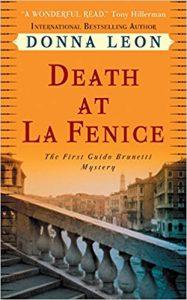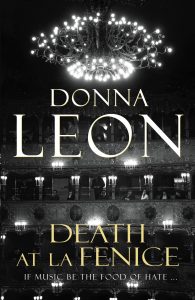Death at La Fenice is Donna Leon’s first novel in her Guido Brunetti series, set in the beautiful city of Venice. Guido Brunetti is a commissario (detective) for the Venetian police and investigates the the death of world-famous conductor Helmut Wellauer, who was poisoned in his dressing room during an opera. The novel is written in 3rd person limited, describing Brunetti’s thoughts to the reader throughout. Brunetti must investigate Wellauer’s death as he discovers the genius had more enemies than he initially suspected. Venice is the perfect setting for this modern cozy, as Leon emphasizes the smallness and interconnectivity of the Venetian community, limiting the list of suspects to the music world of Venice.
The detective dives into the international music world through examining its microcosm in Venice and finds a community full of suspects who all have their own reasons for revenge. Initially, the book begins quickly, with the murder occurring within the first few pages of the novel. The book doesn’t always keep up with that pace, but what it lacks in excitement and thrill it makes up for that in the rich characters and pictures it paints of the city of Venice, through the eyes of Brunetti. Brunetti’s superior, Vice-Questore Giuseppe Patta, is described as lazy, frequently blaming problems on his subordinates but unable to actually solve any crimes on his own. Brunetti is able to piece together an understanding of Wellauer’s own character as he interviews suspect after suspect. While often puzzled at the behavior of some characters, such as the widow Elizabeth Wellauer, soprano Flavia Petrelli, and ex-pat Brett Lynch, the detective doggedly uncovers characters’ secrets until he has unraveled the mystery.
Brunetti’s own character is made clear to the reader throughout the course of the novel; he is a family man who is extremely good at his job, preferring to investigate motive through looking at human dynamics and understanding each suspect, rather than relying on intuition. He stresses this to his wife Paola, who enjoys choosing who she believes is the culprit at the beginning of each case, and who Brunetti says is always wrong,
“Come on, Paola, you know I’m always wrong when I try to work by intuition, when I suspect too much or I suspect too soon.” (199)
Brunetti is painted as a sensitive man who, despite his long years as a detective, has a distaste for the violence he encounters in his work. This is in line with the cozy genre itself, with its general avoidance of excessive violence. Leon rounds out his character throughout the book by giving several glimpses into his past, enabling the reader to understand his character.
At the beginning of his career, Brunetti had asked to attend the autopsy of the victim of the first murder he had investigated, a prostitute killed by her pimp. He had watched intently as the body was rolled into the operating theater, stared fascinated as the white sheet was pulled back from her nearly perfect body. And as the doctor raised the scalpel above the flesh, ready to begin the long butterfly incision, Brunetti had pitched forward and fainted amid the medical students with whom he sat. They had calmly carried him out into the hall and left him, groggy, on a chair before hurrying back to watch. Since then, he had seen the victims of many murders, seen the human body rent by knives, guns, even bobs, but he had never learned to look on them calmly, and he could never again bring himself to watch the calculated violation of an autopsy (61)
As the story was set in Venice, an emphasis on Italian and of language in general was made throughout the novel. Brunetti frequently wrestles with choosing between which form of “you” to use, the informal tu and the formal lei. At times, it felt as though an Italian word was not explained quite enough, leading me to pause in my reading and reach for my phone to make sure I had correctly understood what permesso or antipatico had meant from context, which could be frustrating at times. However, I did enjoy learning about the language as well as the culture surrounding it. The language even played a role in how Brunetti could tell a suspect was beginning to open up to him, as they switched from using lei to tu.
Leon is an ex-pat American who lived in Venice for 30 years and now makes her home in Switzerland; her love for Venice permeates the book throughout the many detailed descriptions of the city, as well as of the people and culture.³ She initially wrote the book as a joke, after a friend suggested she write a crime novel. Leon then laid it aside for several years before submitting it to the Suntory Prize in Japan, where it won, thereby garnering the attention of publishers.¹ Though her books have become popular in many countries, Leon refuses to allow her work to be translated into Italian, saying that she didn’t want the locals to read it and be known as a celebrity while living there.³
This has not stopped the books’ popularity in other countries; a German TV series featuring Brunetti began in 2000, called simply Donna Leon, and has continued to release two episodes per year. I was unable to find a copy of this show to watch it, but was interested to see that Julia Jäger, playing Paola, was nominated for an Adolf Grimme Award for her acting in the series. Based upon the trailer I found for the show, it looks like the series has tried to stay true to the novels, and if you enjoy watching foreign language murder mystery shows, you might like Donna Leon.
The series’ popularity has also led to the publication of a cookbook, a tour book of Venice based upon Brunetti’s own walks, and a walking tour of Venice authorized by Donna Leon.
Overall Reaction:
I would give this novel 4 out of 5 stars. I was able to guess part of the ending, which ended up being a bit predictable, but I truly enjoyed Brunetti and his wife Paola’s characters, making me bump my review up from 3/3.5 stars. Another reason that I enjoyed this book is because cozies are my favorite sub-genre of mysteries. This book is a perfect example of a cozy, with its limited cast of characters set in, from the vivid descriptions, the most delightful of “pleasantvilles” there could possibly be, and the very little violence in the book. If you are looking for action and thrilling adventure, this book is not for you. If you enjoy detailed descriptions of Venice as well as an appreciation for the interspersion of language, cultural, and literature facts into a well-thought out cozy murder mystery, then you may enjoy this book.
References and additional resources:
2. Leon, Donna. Death at La Fenice. Harpertorch, 1992.



